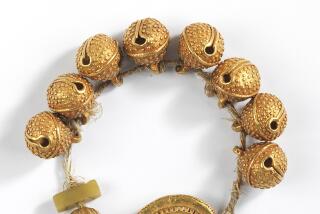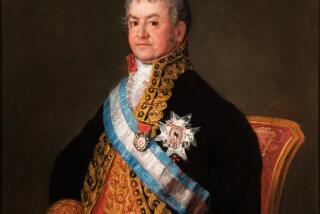Turning Bronze to Gold
- Share via
SHANGHAI — Until last month, many of the finest art treasures from one of the world’s proudest cultures were stashed in dark corners of a library, on storeroom shelves, in foreign collections and even in smugglers’ warrens.
Now, thanks to a tenacious director, two sophisticated mayors and generous donors, artworks stretching back thousands of years into Chinese history are on permanent, public display, many for the first time. And this grand port city has a striking new museum, housing what many call the world’s finest collection of Chinese bronzes and other national prizes.
The museum [Shanghai Museum of Art? we never name it otherwise] is dedicated to the spirit of China’s illustrious past, though in a way that is completely new for the country.
While most national art institutions are closely guarded, dark and stuffy, the new five-story museum is arranged in an open, accessible manner so visitors can get up close to artifacts, see the pictures and read the stories for themselves.
A few rare Buddhist sandstone sculptures are out in the open, naked to the curious fingers of children who have been discreetly warned not to touch. Exhibits show how porcelain is fired and how bronzes are thought to have been made--a secret perfected by ancient masters that cannot be completely replicated even now.
The exhibition space contains 14 galleries, three of which are now open, showing porcelain, Buddhist sculptures, calligraphy, coins, paintings and other arts.
But what will put this museum on the international art map is its bronzes, said to be the world’s best. The museum has almost 7,000 pieces, with a selection of 334 objects on rotating display.
“The bronze is the most important symbol of China’s civilization,” says Ma Chengyuan, the museum’s director and one of the world’s top authorities on bronzes. “It’s like sculpture in Rome--bronze is China’s counterpart. It has pictures and inscriptions that tell us about the lifestyle of ancient lords in a way that histories don’t.”
Today, children swarm through the galleries and throng around one wine vessel--a piece of a legend every student knows by heart about two warring kings and the concubine that led to a decadent ruler’s downfall.
It was 468 BC, the Warring States Period, and the rulers of the kingdoms of Yue and Wu, which now make up the coastal region near Shanghai, were at battle. After the ruler of Yue lost his kingdom to the ruler of Wu, the story goes, he bestowed the new king with riches and a beautiful concubine, Xi Shu. While the new king luxuriated in his spoils and lost himself to the charms of his new mistress, the former leader of Yue slept on the forest floor and each day drank pig bile to sharpen his bitter taste for revenge. And he ultimately won back the kingdom.
The story of the Yue ruler’s victory over the profligate Wu was considered historical lore until the discovery of a bronze wine vessel last year in a Hong Kong antique shop. The inscription--”Fuchai used the material of kings to build a woman’s vessel”--marked it as a gift from the king of Wu to his special concubine, validating part of the legend. Now the vessel, adorned by a handle made of hundreds of tiny intertwined dragons and decorated with intricate spiraled engravings, is a centerpiece in the new museum.
“Every bronze tells a story,” Ma says. “But that one is special.”
The vessel, representing the victory of tenacity over greed, holds particular resonance for Ma, who for 40 years patiently bought, begged and brought back lost and stolen bronzes to China and persuaded the city to build a showcase worthy to house them.
The $70-million museum, which itself resembles a bronze urn, also represents a victory of art over avarice--it occupies a spot much coveted by developers eyeing prime real estate in Shanghai’s center.
“We’re very lucky to be in People’s Square,” Ma says of the central public plaza filled with families flying kites and feeding overstuffed pigeons. “This place could be filled with skyscrapers. Instead, we had a chance to build a landmark.”
Across the nearby Huangpu River looms Shanghai’s other landmark--the world’s tallest television tower, a science-fiction-like spire spearing several red glass orbs. It is a structure that aptly captures the go-go spirit of Shanghai’s future--and a stark reminder of the importance of preserving the classic vestiges of its past.
“The former mayor supported us, though there was a lot of criticism that the government had no commercial sense,” Ma says with a chortle.
Art critics have wholeheartedly praised the collection’s breadth and its elegant, accessible display.
“In my opinion, it is the finest collection in the world,” says London-based art critic and bronze expert Giuseppe Eskanazi, “in selection, quality, rarity and size.”
Shanghai-born New York art maven Diane Woo concurs: “If there were three fires, and I had one pail of water,” she says, referring to other prominent collections in Taipei, Taiwan, and in Washington, “guess which one I’d save.”
Many of the prize pieces ended up in the Shanghai museum precisely because of that kind of choice made in the heat of crisis. People needing quick cash during wartime found a buyer in the mayor of that time, who was trying to keep the city’s treasures intact. Some artifacts were confiscated from defeated Nationalists as they fled in 1949. And other donations came during the 1966-1976 Cultural Revolution, when collectors needed a place safe from zealous Red Guards charged with destroying ancient imperial relics.
Ma, who has been a curator of Shanghai’s museum in its various forms since 1952, has been just as zealous in building and protecting the collection. Museum workers warded off Red Guards, he told friends, by donning red armbands and telling other factions that they would “take care” of the “feudal remnants.”
Even now--especially now--Ma’s search continues. When a Hong Kong antique dealer discovered the concubine’s wine vessel, he asked Ma to authenticate it. Recognizing its rarity and historical value, the director immediately wanted it for the museum and scrambled to find a donor.
He found one in Eric Ho-tung, a Hong Kong businessman from a prominent Shanghai family who had already financed a pavilion for the museum.
“I did it on the spot,” Ho-tung says. “It’s terrible for a curator to see a treasure disappear before his eyes because he doesn’t have the money.”
More to Read
Sign up for The Wild
We’ll help you find the best places to hike, bike and run, as well as the perfect silent spots for meditation and yoga.
You may occasionally receive promotional content from the Los Angeles Times.






